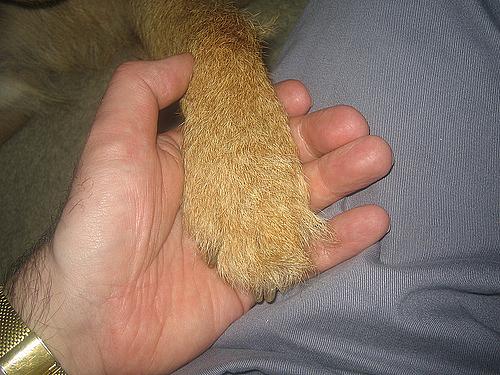You big, beautiful dog, you!

The day I got my cancer diagnosis was the day I relaxed my strict rule against allowing my dog Biko up onto my bed. A beautiful 6-year-old Rhodesian Ridgeback whose coat has a reddish tint and whose eyes are a rich brown, Biko nestled his 95-pound body next to me. He seemed to appreciate the luxurious linens, plush pillows and other creature comforts formerly denied him.
I hung my head over his outstretched body, my hair draped over him, and stroked his side, consumed by unremitting distress. As if imparting a secret, I whispered to him that I have cancer and said I feared he would outlive me. I told him I was sorry.
As hard as it was to utter those words, I could feel a psychological and physiological lift within me as I touched him and talked to him.
It was magical.
Canine therapy, in which patients socialize with dogs to promote healing and well-being, is a well-accepted practice in medicine today. It has been shown to help people suffering from heart failure, post-traumatic stress disorder and — for those like me — cancer.
Studies show the love of a dog lowers blood pressure and reduces stress hormones, such as cortisol and adrenaline. Canine therapy also increases naturally occurring healthy hormones such as oxytocin, dopamine and endorphins.
Some of the nation’s top cancer centers including Memorial Sloan-Kettering Cancer Center, MD Anderson Cancer Center, and the Mayo Clinic have created canine units to provide dogs for their patients.
Socializing with a well-trained dog provided by the hospital is helpful, but visiting with your own dog with whom you have your own special bond is even better for one’s health, according to Dr. Mara Baun, a professor at the University of Texas School of Nursing at Houston.
Baun established a program to get patients’ dogs into hospitals with the help of a non-profit organization called Pets are Wonderful Support, or PAWS.
Methodist Hospital was the first hospital in Houston that adopted the program.
“Then it took four years to get into the next hospital and from there it was a domino effect,” said PAWS volunteer Donna Dishman.
Other Houston-area hospitals with programs include the MD Anderson Cancer Center and Children’s Hospital, Memorial Hermann Hospital, St. Luke’s Episcopal Hospital, Texas Children’s Hospital, Select Specialty Hospital and Kindred Hospitals in the Houston Medical Center.
Dishman witnessed one case of a woman in a coma whose dog was brought in and allowed onto her hospital bed. “Her eyes fluttered, she spoke and she went home and lived for three more years,” said Dishman, who has witnessed numerous positive outcomes from canine therapy.
Baun’s conclusion may come as no surprise to people who have a loving relationship with their dog.
I have my own dedicated dog for therapy, and I decided to adopt another one when Biko’s sister had puppies a few months ago.
Some outside of my family questioned whether caring for two dogs at this difficult time in my life was wise. Would I have enough energy? Enough patience? Enough time? My answer is that this puppy would be the only thing in my life, besides Biko, that didn’t care about cancer. Everyone and everything else had seemingly become a consideration of the disease.
So we took the runt of the litter, a female, weighing only 4.5 ounces at birth. Our breeder, Tina, worried that the pup she called Daffodil might not survive, as the smallest pup she had ever raised had weighed 8 ounces.
A nurse by trade, Tina cared for her day and night and she thrived. And so we renamed the new member of our family Tina. Caring for and training this fragile but fast-growing puppy has had a positive effect on me that I cannot imagine getting from any human.
I hope one day I can say Tina and Biko had a paw in my recovery.
This post originally ran on the Reuters blog "Cancer In Context" and has been reposted with permission.
Image by Menage a Moi via Flickr

